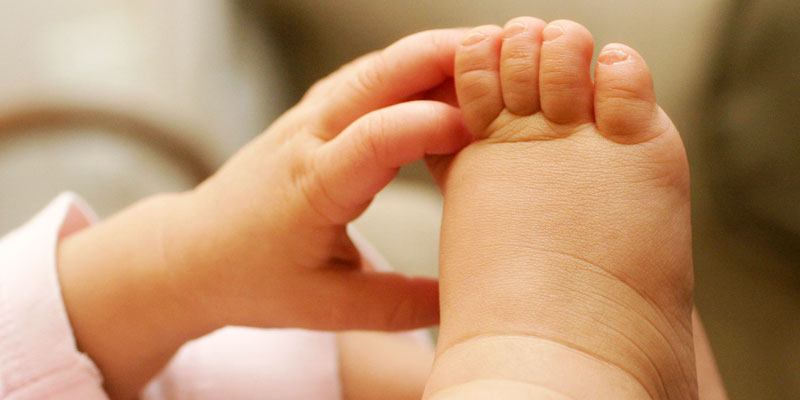
Foot Grasping and Other Advances in Your Baby’s Movement
By the time your baby is 3-6 months old, you’ll be noticing some new developments in his ability to move. His muscles are growing stronger, and as he develops his Body Movement skills, he is able to move much more easily than he could just a couple months ago. As he becomes aware that his body parts are under his own control, you will find him making movements that are more deliberate and goal-oriented, such as reaching towards interesting objects and turning his head when he hears your voice.
(SPECIAL OFFER: Sign up for Playful Bee’s Bee Well developmental learning program to give your baby the best start in life. The first 10,000 children enroll for FREE! Sign up today.)
He will be exploring his own body parts more readily at this age by grabbing at his toes,1 playing with his hands and fingers,2 and even reaching for his genitals during a diaper change.3 This is an exciting time for your baby as he realizes that he can feel his body both inside and out, fueling his curiosity to explore how his body feels and moves at every chance he gets.
You may have noticed a couple interesting behaviors that your baby demonstrates with his feet. Young babies have a foot grasping reflex, in which their toes will grasp objects that touch the bottoms of their feet.4 Go ahead and try touching just beneath his toes with your finger! Babies also enjoy touching their feet together, sometimes bracing them on each other. This behavior may seem random at first, but it’s actually an effective method your baby learns to self-regulate his own behaviors and steady his random leg movements during this early stage in life.5 Babies often find this action comforting,6 perhaps due to the steadying feeling.
By the end of this period, your baby will be able be hold his head up and sit with the support of firm pillows or other props.7 He may have developed enough gross motor strength to start moving his body forward or backward, largely through the use of his arms.1 What’s exciting is that this ability is a stepping stone to learning how to crawl! While not all babies learn to crawl, it is a great time to encourage these movements as it will help build his upper body and trunk strength for the other important physical skills he will master in the coming months, including sitting up unsupported, pulling himself up to standing, and eventually walking.
Play Tips:
Do you want to know how you can support your baby’s development of these Body Movement skills at this age? It’s easy! Read on for some simple tips to incorporate into your daily play time together.
- Encourage tummy time activities.7 Tummy time helps build the upper neck and back muscles that will lead to rolling, crawling, and sitting. Help your baby exercise these muscles by doing tummy time daily. If he does not take to using the floor, try placing him on your chest looking up at you or over your knee while you are seated.
- Offer sitting time opportunities throughout the day.7 Provide your baby some “sitting” time by using support pillows that help prop up his body and keep his head steady or support him in a seated position on your lap. This will help him develop the muscle memory and strength to allow him to sit unsupported. Be sure to keep the duration short and supervised, and watch out for any signs that he is tired or uncomfortable.
- Use an infant foam floor seat for supported sitting time. Once your baby has developed his upper back and neck muscle strength and exhibits a mastery of sitting within propped pillows, consider graduating him to sitting in a foam floor seat, such as the umbo seat.
(SPECIAL OFFER: Sign up for Playful Bee’s Bee Well developmental learning program to give your baby the best start in life. The first 10,000 children enroll for FREE! Sign up today.)
Developmental Milestones:
Has your baby achieved the following Body Movement developmental milestones yet? If yes, check off all the skill(s) he has already mastered to date using Playful Bee’s developmental milestones tracker. It’s absolutely FREE and easy to use, just click HERE!
- Sits supported, head steady.
Sources:
1Maryland State Department of Education (2010). Healthy Beginnings: Supporting Development and Learning from Birth through Three Years of Age.
2Florida Partnership for School Readiness (2004). Florida Birth to Three Learning and Developmental Standards.
3BabyCenter Editorial Team. Is It Normal for My Baby to Tug on His Penis? BabyCenter.Retrieved January 27, 2014, from http://www.babycenter.com/404_is-it-normal-for-my-baby-to-tug-on-his-penis_3652527.bc.
4Stanford School of Medicine. Grasp Reflex of the Foot. Stanford School of Medicine: Newborn Nursery Information. Retrieved January 27, 2014, from http://newborns.stanford.edu/PhotoGallery/FootGraspReflex1.html.
5Nugent, Kevin, and Morell, Abelardo (2011). Your Baby is Speaking to You. New York, NY: Houghton Mifflin Harcourt.
6VandenBerg, Kathleen; Browne, Joy V.; Perez, Linda; and Newstetter, Amanda (2009). Getting to Know Your Baby. WONDERbabies (Ways Of Nurturing Development through Enhancing Relationships). Retrieved January 27, 2014, from http://www.wonderbabiesco.org/resources.php.
7Texas Early Learning Council. Little Texans, Big Futures: Your Early Learning Guide for Infants, Toddlers, and Three-Year-Olds.
Playful Bee
Latest posts by Playful Bee (see all)
- Have a Super Fortune Cookie Friday! - February 9, 2018
- All Kinds of Shapes: Your Child Is Learning Simple Shapes, and Drawing Them Too! - November 13, 2017
- Fishing for Sneakers: Create your own Hand-Eye Coordination Fun - November 11, 2017

+ There are no comments
Add yours